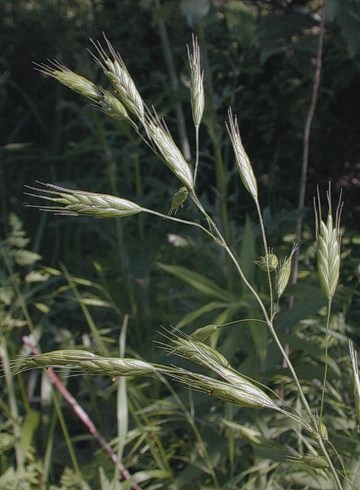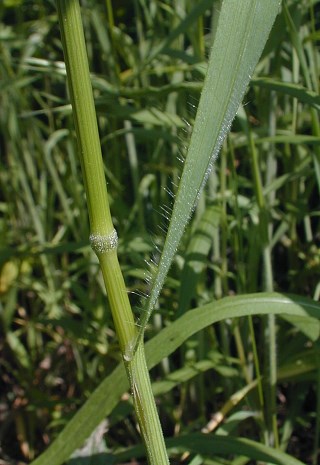Description: This annual grass is 1¼–3' tall. The erect central culm is unbranched, light green, terete, and glabrous; it is mostly hidden by the sheaths. There are 4-8 alternate leaves along the entire length of each culm, except near the apex where the inflorescence occurs. The nodes along each culm are swollen, dark-colored, and sometimes pubescent; they are mostly hidden by the sheaths. The leaf blades are up to 7 mm. across and 9" long; they are medium green and widely spreading to ascending. The upper surface of each blade is sparsely to moderately hairy near its base, becoming more glabrous toward its tip; the lower surface is hairless or short-pubescent. The leaf sheaths are dull green and either glabrous or hairy. In general, the hairiness of the leaves (whether blades or sheaths) can be variable across different populations of plants.

Each culm
terminates in a panicle of spikelets up to 7" long and 4" across; this
panicle is rather open and its branches are either bilateral or droop
to one side. Individual branches are organized along the central axis
of the inflorescence in whorls of 3-5, except near its apex, where
branches occur individually or in pairs. These branches are subdivided
into branchlets; they are slender, rough-textured, and either ascending
or drooping. The branchlets terminate in individual spikelets. Each
spikelet is 1-2 cm. long, 4-6 mm. across, and somewhat flattened; it
consists of 2 glumes and 4-10 awned lemmas that are organized into 2
columnar ranks. The glumes are unequal in size; the smaller glume is
4.5–5.5 mm. with 3 veins, while the larger glume is 6.0–7.0 mm. long
with 5-7 veins. Both glumes are linear-elliptic with curved outer
surfaces. The elliptic-oblong lemmas are 7.0–8.0 mm. long (excluding
their awns); the straight awns are 4.0–6.0 mm. in length (rarely are
they 1 mm. or less in length). The lemmas are curved, rather than
keeled, along their outer surfaces; each lemma has 5-9 obscure veins.
Both the glumes and lemmas lack conspicuous hairs. Within each lemma,
there is a white-membranous palea of about the same length. The florets
of the lemmas have anthers about 1-2 mm. in length. The blooming period
occurs from late spring to mid-summer; the florets are cross-pollinated
by the wind. The large grains are linear-oblongoid in shape and quite
light for their size. The root system is fibrous. This grass reproduces
by reseeding itself.
 Cultivation:
The preference is full sun and mesic to dry conditions. This grass will
adapt to practically any kind of soil; in areas with exposed open
ground, it can reseed itself aggressively.
Cultivation:
The preference is full sun and mesic to dry conditions. This grass will
adapt to practically any kind of soil; in areas with exposed open
ground, it can reseed itself aggressively.
Range & Habitat:
The non-native Common Chess is common in southern and western Illinois;
elsewhere in
the state, it is occasional to locally common (see Distribution
Map). It is possible that this grass occurs in every county
of the state; if not, it soon will. Common Chess is native to Eurasia.
Habitats include dry prairies, limestone glades, disturbed grassy
meadows, vacant lots, abandoned fields, cropland (especially wheat
fields), areas along railroads, and waste areas. This weedy grass is
typical of habitats with a history of disturbance.
Faunal Associations:
A variety of insects feed on Common Chess and other annual Bromus
spp. (Brome grasses). These insects include the stink bugs
(Pentatomidae) Aelia americana, Cosmopepla
lintneriana, Hymenarcys aequalis, Hymenarcys
nervosa, and Mormidea lugens, larvae of Cephus pygmaeus (European Wheat-stem Sawfly), and Chalepus walshii (Leaf Beetle sp.) and Oulema
melanopus (Cereal Leaf Beetle). Many species of grasshoppers feed on these Brome
grasses in the sunny meadows and fields where these grasses typically
occur; the Grasshopper Table lists these
species. Among vertebrate animals, the seeds and foliage are eaten by
Prairie Voles and other small rodents, while the foliage of immature
plants are edible to White-Tailed Deer, cattle, and other mammalian
herbivores. The seeds are eaten to a minor extent by upland gamebirds
and sparrows. Because the awns of the mature lemmas can cling to fur
and clothing, the seeds of Common Chess are spread into new areas by
animals and humans.
Photographic Location:
A meadow at Judge Webber Park in Urbana, Illinois.
Comments:
This grass is often referred to as 'Chess' or 'Cheat,' although these
common names may refer to other annual Bromus spp.
(Brome grasses) from Eurasia. As a group, these annual Brome grasses
are weedy and aggressive, preferring habitats that are sunny and
disturbed. Common Chess is more common within the state than some of
the other species, however. These species are difficult to distinguish
from each other. Common Chess has awns that are straight and about 4-6
mm. long, while other similar species in this group have awns that are
curved and/or slightly longer (mostly exceeding 6 mm. in length). Other
critical features include the length of the anthers, number of veins on
the glumes, and whether the outer sides of the lemmas are curved or
keeled. Some authorities state that the sheaths of Common Chess are
glabrous; in my experience, the sheaths of this species can be either
glabrous or hairy.